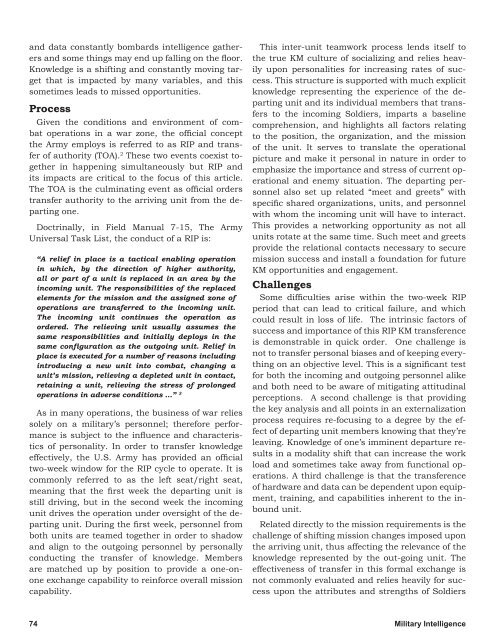George w. casey jr. - Federation of American Scientists
George w. casey jr. - Federation of American Scientists
George w. casey jr. - Federation of American Scientists
You also want an ePaper? Increase the reach of your titles
YUMPU automatically turns print PDFs into web optimized ePapers that Google loves.
and data constantly bombards intelligence gatherers<br />
and some things may end up falling on the floor.<br />
Knowledge is a shifting and constantly moving target<br />
that is impacted by many variables, and this<br />
sometimes leads to missed opportunities.<br />
Process<br />
Given the conditions and environment <strong>of</strong> combat<br />
operations in a war zone, the <strong>of</strong>ficial concept<br />
the Army employs is referred to as RIP and transfer<br />
<strong>of</strong> authority (TOA). 2 These two events coexist together<br />
in happening simultaneously but RIP and<br />
its impacts are critical to the focus <strong>of</strong> this article.<br />
The TOA is the culminating event as <strong>of</strong>ficial orders<br />
transfer authority to the arriving unit from the departing<br />
one.<br />
Doctrinally, in Field Manual 7-15, The Army<br />
Universal Task List, the conduct <strong>of</strong> a RIP is:<br />
“A relief in place is a tactical enabling operation<br />
in which, by the direction <strong>of</strong> higher authority,<br />
all or part <strong>of</strong> a unit is replaced in an area by the<br />
incoming unit. The responsibilities <strong>of</strong> the replaced<br />
elements for the mission and the assigned zone <strong>of</strong><br />
operations are transferred to the incoming unit.<br />
The incoming unit continues the operation as<br />
ordered. The relieving unit usually assumes the<br />
same responsibilities and initially deploys in the<br />
same configuration as the outgoing unit. Relief in<br />
place is executed for a number <strong>of</strong> reasons including<br />
introducing a new unit into combat, changing a<br />
unit’s mission, relieving a depleted unit in contact,<br />
retaining a unit, relieving the stress <strong>of</strong> prolonged<br />
operations in adverse conditions …” 3<br />
As in many operations, the business <strong>of</strong> war relies<br />
solely on a military’s personnel; therefore performance<br />
is subject to the influence and characteristics<br />
<strong>of</strong> personality. In order to transfer knowledge<br />
effectively, the U.S. Army has provided an <strong>of</strong>ficial<br />
two-week window for the RIP cycle to operate. It is<br />
commonly referred to as the left seat/right seat,<br />
meaning that the first week the departing unit is<br />
still driving, but in the second week the incoming<br />
unit drives the operation under oversight <strong>of</strong> the departing<br />
unit. During the first week, personnel from<br />
both units are teamed together in order to shadow<br />
and align to the outgoing personnel by personally<br />
conducting the transfer <strong>of</strong> knowledge. Members<br />
are matched up by position to provide a one-onone<br />
exchange capability to reinforce overall mission<br />
capability.<br />
This inter-unit teamwork process lends itself to<br />
the true KM culture <strong>of</strong> socializing and relies heavily<br />
upon personalities for increasing rates <strong>of</strong> success.<br />
This structure is supported with much explicit<br />
knowledge representing the experience <strong>of</strong> the departing<br />
unit and its individual members that transfers<br />
to the incoming Soldiers, imparts a baseline<br />
comprehension, and highlights all factors relating<br />
to the position, the organization, and the mission<br />
<strong>of</strong> the unit. It serves to translate the operational<br />
picture and make it personal in nature in order to<br />
emphasize the importance and stress <strong>of</strong> current operational<br />
and enemy situation. The departing personnel<br />
also set up related “meet and greets” with<br />
specific shared organizations, units, and personnel<br />
with whom the incoming unit will have to interact.<br />
This provides a networking opportunity as not all<br />
units rotate at the same time. Such meet and greets<br />
provide the relational contacts necessary to secure<br />
mission success and install a foundation for future<br />
KM opportunities and engagement.<br />
Challenges<br />
Some difficulties arise within the two-week RIP<br />
period that can lead to critical failure, and which<br />
could result in loss <strong>of</strong> life. The intrinsic factors <strong>of</strong><br />
success and importance <strong>of</strong> this RIP KM transference<br />
is demonstrable in quick order. One challenge is<br />
not to transfer personal biases and <strong>of</strong> keeping everything<br />
on an objective level. This is a significant test<br />
for both the incoming and outgoing personnel alike<br />
and both need to be aware <strong>of</strong> mitigating attitudinal<br />
perceptions. A second challenge is that providing<br />
the key analysis and all points in an externalization<br />
process requires re-focusing to a degree by the effect<br />
<strong>of</strong> departing unit members knowing that they’re<br />
leaving. Knowledge <strong>of</strong> one’s imminent departure results<br />
in a modality shift that can increase the work<br />
load and sometimes take away from functional operations.<br />
A third challenge is that the transference<br />
<strong>of</strong> hardware and data can be dependent upon equipment,<br />
training, and capabilities inherent to the inbound<br />
unit.<br />
Related directly to the mission requirements is the<br />
challenge <strong>of</strong> shifting mission changes imposed upon<br />
the arriving unit, thus affecting the relevance <strong>of</strong> the<br />
knowledge represented by the out-going unit. The<br />
effectiveness <strong>of</strong> transfer in this formal exchange is<br />
not commonly evaluated and relies heavily for success<br />
upon the attributes and strengths <strong>of</strong> Soldiers<br />
74 Military Intelligence















